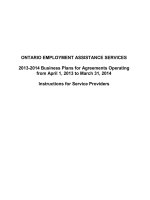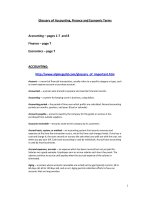Finance for Non-Financial Managers potx
Bạn đang xem bản rút gọn của tài liệu. Xem và tải ngay bản đầy đủ của tài liệu tại đây (144.17 KB, 11 trang )
T
he members of every generation believe the business envi-
ronment in which they work is tougher than ever before.
Today we are no exception. Those who follow us will likely be
no exception. Well, guess what? Everybody’s right!
Managing a Company in Today’s Business
Environment
As business gets more competitive, more global, more techno-
logically driven, it gets easier for others to compete with you. It
gets harder to be successful by just doing OK. It gets harder to
launch a good product and enjoy the benefits of your innovation
for a long time without serious competition. And, yes, it does get
tougher to make a living. So what was good enough for our par-
ents to be able to get by and make a “good living” isn’t good
enough today. You may have read that many of us will fail to
achieve the relative standard of living that our parents did
because of that tougher world out there. Of course, if you’ve
1
Counting
the Beans:
How Critical Is Good Financial
Information, Anyway?
1
been alive for the past 10 or 15 years, you also know that there
are unprecedented opportunities to create new wealth, new
products, new companies, and new fortunes that never before
existed. It’s unlikely that our forefathers could have imagined for-
tunes being made, and lost, as quickly as they were in the ’90s.
So it’s hard to argue that times are more challenging now.
The question is: what can you do about it? The answer: not
much about the times, but a lot about how you prepare for
them. And that’s what this book is all about.
When I was a young boy, my father owned and ran a small
grocery store that supplied the neighbors with their daily house-
hold needs, long before supermarkets killed the mom-and-pops
that then existed in every neighborhood. When school was over,
I went to the store to help out, because mom and dad were both
working there. My first job was opening cases of packaged
goods, pricing the packages, and stocking the shelves. Then I
packed groceries and delivered them to customers, sometimes
after taking their order over the phone and personally filling it.
(Yes, that was how many small stores did business back then.)
Then I graduated to cutting meat in the fresh meat department.
By the time I was in junior high school, I was checking out cus-
tomers, opening the store in the morning, and finally running
the store when my parents went on a rare vacation. By the time
I was in high school, I had run every aspect of a small business,
including opening and closing the cash register and doing the
bookkeeping at the end of the day.
In today’s business terms, I had worked in shipping/receiv-
ing, warehousing and inventory control, production, sales, deliv-
ery, billing and collection, accounting, and management.
Uncommon today? Yes, and yet that diverse background is
exactly what is being demanded more and more of today’s up-
and-coming professionals. Managers in companies large and
small, including directors, vice presidents, and general man-
agers, are finding their particular specialties aren’t going to
carry them to the finish line as they might once have.
Their first clue might have been the arrival of the personal
Finance for Non-Financial Managers2
computer. Senior managers and company executives a genera-
tion ago were challenged by their lack of knowledge of this new
tool, no matter how firmly they knew their own particular areas
of expertise. The young professionals coming into the business
often made their bosses look old-fashioned with their mastery of
this impressive and intimidating technology. Soon, as we discov-
ered, those young professionals had children, whose computer
acumen after being on the planet for only a few years made
even their savvy parents sit up and take notice. And so it goes.
Now, as we are learning, finance and accounting are having
an impact on many companies in ways never before thought of
by managers outside the financial department. The accounting
scandals of 2002 showed that financial incompetence, or care-
lessness, or simply lack of integrity, could wipe out the efforts of
thousands of loyal, hard-working employees. The report card, it
seems, has become more important than it ever was when we
were in school.
Today we’re finding out that we need to know how to read a
report card so we can just keep our jobs, let alone advance in our
careers. Boards of directors now need to delve into the reports
they have routinely received for years to a degree never before
contemplated. They need to understand financial terminology and
accounting methods they might previously have taken for grant-
ed. CEOs now need to be completely aware of what their people
are doing and the financial ramifications, because they will no
longer be able to credibly say they didn’t know. And finally, man-
agers within a company, whether large or small, are going to
need to understand the rules of accounting and the boundaries of
proper finance well enough to avoid getting into trouble just
because they were aggressively trying to make their goals. As for
those who aspire to become managers, they might not even get
started up the ladder until they can demonstrate this kind of
knowledge. So you see, it touches everyone.
Now, it’s all well and good to say that accounting scandals
will make everyone learn more about finance and accounting,
but is that the only reason to know this stuff? Of course not!
Counting the Beans 3
Consider the new manager
who is asked to prepare a
budget for his or her
department.
How do you begin your
budget? Well, how about
sales? Do you start with
what you hope you can
sell? What you’re sure you
can sell? What you sold
last year or last month?
What will management believe?
OK, if that’s too confusing, maybe you should start with
expenses. What do you need to spend? What you spent last
year or last month? What you hope you can get approval to
spend? Do you actually know what it will really cost?
Just knowing where to begin is a challenge. And then how
do you decide how much money or staffing you’ll need to reach
the goals you want to achieve or that your boss wants you to
achieve?
Whew! Why can’t Finance just do this for you?
And the truth is, of course, they really can’t. Oh, sure,
Finance can prepare something that looks like a budget and in
many companies that’s what happens. But then it’s not really
your budget; it’s theirs. And if you miss the target they set, well,
it’s not really your problem, now, is it? Yet as managers we
know that each department knows its unique needs and capa-
bilities better than anyone else. And we know from Management
101 that a goal must be accepted—better yet, owned—by the
people who actually will do the work, for there to be a strong
commitment to achieving it. And that, simply put, is why each
department within the organization must do its own budget and,
therefore, why its managers must learn to budget effectively.
And, yes, you will need to be able to answer, at some level, all
the questions I’ve raised above. Happily, Chapter 10 in this
book will help you do that.
Finance for Non-Financial Managers4
Budget A projection of
the detailed income and
expenses that we estimate
will occur in a future period, usually
prepared on a month-to-month basis
for up to a year. Each kind of income
and expense is listed, along with the
amount each line is expected to add
to or subtract from the profit for the
period.
The Role of the Finance Department
The Finance Department really has two fairly distinct jobs to
perform in most companies: managing the company’s financial
resources (“Finance”) and recording and reporting all its finan-
cial transactions (“Accounting”). Many of today’s mid-sized and
smaller companies don’t establish separate Finance and
Accounting departments within their organizations. A company
might instead have a chief financial officer who per-
forms or oversees the
finance functions for the
company and oversees the
company’s accounting
activities. Larger compa-
nies will usually be fairly
precise about their organi-
zation and are likely to
have distinctly separate
departments reporting to
the CFO.
Finance
The Finance Department can be an accumulation of diverse
functions, depending on the company. It may oversee such
areas as insurance and risk management, contract administra-
tion and pricing, internal auditing, investor relations, and more.
But at a minimum, Finance will likely be responsible for treas-
ury activities, often under an executive carrying the title of
treasurer or vice president for finance. His or her role will likely
include cash management, bank relations, investments, and
everything having to do with making sure the organization has
enough cash to do its job and has all its cash busily working or
productively invested.
Major activities like mergers and acquisitions, attracting
investors to a company seeking outside capital, and internal
management of public stock offerings—all traditional roles of
Finance—will usually fall within the Finance Department’s
Counting the Beans 5
Chief financial officer
(CFO) The job title of the
executive who is in overall
charge of all the financial department
activities in all large companies and
most mid-sized ones. Smaller compa-
nies might instead place their financial
department under a vice president
for finance or even a controller,
depending on how they define the
responsibilities of these people.
responsibility. A company that decides to take its stock to the
public marketplace for the first time—in an initial public offering
(IPO)—will almost always place the coordination role for that
transaction in the hands of the Finance Department.
Accounting
The accounting job is typically done by the Accounting
Department, led by an accounting manager, controller, comp-
troller, or similar title. These folks record all the transactions that
occur as the company does its business and then prepare
reports that help them, company management, and outside con-
stituencies understand the financial impact of those transactions.
The accountants maintain the accounting software, process
all the paperwork that documents transactions that have
occurred, and record them into the company’s general ledger.
Most of these transactions are recorded in dollars and cents, or
the appropriate foreign currency for operations outside the U.S.
Some transactions keep track of other units of measure besides
currency, such as the number of pieces of inventory in the ware-
house, the number of vehicles in the company fleet, and so on.
Of course, keeping records of financial transactions tucked
away in some computer serves no one unless we can get
access to the information when we need it. So, from all those
transaction records the accountants are able to prepare a vari-
Finance for Non-Financial Managers6
Don’t Judge the Executive
Book by Its Cover
While we have tried to give you a general idea of what job titles might
do which jobs, these are generalizations that do not apply to every
company, and maybe not yours. Some companies are more liberal than
others in granting titles. Still others might employ little-used titles such
as “director of finance” or “vice president of administration” or even
“manager of accounting” to indicate the head financial executive in
their organization. It’s best to obtain an organization chart or ask
someone in Human Resources or the Finance Department when
determining exactly who does what. It could save you embarrassment
or, even worse, getting the wrong information.
ety of reports. Some are
for people outside your
company, like the govern-
ment, your bankers,
investors, and stockhold-
ers. But most important to
running the company are
the reports the account-
ants prepare for company
managers, for it is those
reports that managers use
to understand their compa-
ny’s financial past and make decisions about its financial future.
As you will learn later in this book, or as you may already
have discovered the hard way, the readability of those reports is
a huge factor in their value. Put another way, it’s hard to use a
report you can’t understand, no matter how valuable the infor-
mation it contains.
That, unfortunately, is the way some managers view the
basic financial reports their companies’ computerized account-
ing programs typically produce. (We’ll discuss these reports in
depth in Chapters 3 and 4.) Managers often have good reason
to feel that way, it seems to me, because these basic financial
reports were designed primarily for use by outsiders! Their pur-
pose is to give a snapshot of a company’s financial condition to
people outside the company—bankers, government regulators,
stock analysts, investors, and others who have no direct role in
running the company. While that may be true, these reports still
provide an essential summary of the company’s monthly or
quarterly operations in a standard format that is consistent and
familiar, thus making them more credible and useful. They also
serve as the basis for more tailored and typically more useful
reports, which we’ll discuss later on in this book.
GAAP: The “Rules” of Financial Reporting
The standard format for recording and reporting financial trans-
Counting the Beans 7
General ledger The prin-
cipal accounting record into
which all transactions of the
company are recorded and summa-
rized.The general ledger is the record
from which information for the basic
financial reports is drawn. It varies
greatly in appearance.These were
once huge books maintained with
carefully handwritten entries, but
nearly all general ledgers today are
produced by computer software.
actions is outlined in guidelines, or rules, called Generally
Accepted Accounting Principles (GAAP). These guidelines are
published by the accounting profession (with some gentle help
from the U.S. government). They are intended to be the founda-
tion upon which report readers can gauge a company’s
progress, compare one company or one accounting period with
another, and generally
judge the financial effec-
tiveness of its manage-
ment efforts.
As we’ve seen, it does-
n’t always work out that
way, but that’s not neces-
sarily because the rules
are flawed. The job of cre-
ating comparable accounting and reporting standards for busi-
nesses as widely varied as those operating today can be a
daunting task for the folks who set the standards. The objective
of each accounting rule is to record a transaction so that it
makes economic sense for the company and for readers of the
company’s reports. Yet to achieve that objective, accountants in
two dissimilar companies might need to record the same trans-
action differently.
We will devote a fair amount of time in this book to helping
Finance for Non-Financial Managers8
You Don’t Get What You Don’t Ask For
Some accounting departments produce reports that they
never distribute outside their department, because no one
has ever asked for them.These reports, perhaps produced as part of a
standard computerized process or to serve a limited purpose in
Accounting, might contain information you have been trying to collect
on the back of an envelope for months. If they don’t know you want
it, they’re not likely to go looking for you when it’s printed. Ask what
kinds of reports are produced that don’t get distributed, just in case
there is a gem hidden in that file cabinet. Of course, this also applies
to reports that aren’t printed but are accessible through your comput-
er network.
Generally Accepted
Accounting Principles
(GAAP) A set of rules,
conventions, standards, and proce-
dures established by the Financial
Accounting Standards Board for
reporting financial information.
you understand how to read and use these primary financial
statements, prepared in accordance with GAAP. We will also
discuss other, special-purpose reports that company manage-
ment may find more useful for internal purposes. Our com-
ments will in all cases assume the use of GAAP, except where
we specifically note exceptions.
The Relationship of Finance and Accounting to the
Other Departments
The Finance Department in every company has in theory two
primary areas of responsibility:
• To safeguard the assets of the company by properly
accounting for them, instituting internal controls to pre-
vent their misuse or loss, and generally monitoring their
proper use. In this role, Finance becomes something of
Counting the Beans 9
Are All Fords Created Equal?
Two companies purchase identical Ford Taurus automobiles.
Company A will use its vehicle for occasional corporate vis-
itors, so it’s expected to last about five years. Company B will use its
vehicle as part of its fleet of taxis, so it’s expected to last about 18
months. Over which of the following periods of time would an
accountant depreciate or expense the purchase?
1. five years
2. 18 months
3. three years (an average)
4. different lives in different companies, based on their actual useful
life in those companies
The choice will affect the profits of any company that buys cars.The
choices that companies must make to reflect their particular realities
might lead to confusion and misstatement. However, setting one
absolute rule for all companies would create different confusion, per-
haps greater.Thus arose the concept of generally accepted accounting
principles, rather than absolute rules.These principles have been the
basis for reasonable estimates and unreasonable abuses for many
years, with the abuses getting a lot more press as this is written.
Incidentally, the answer is 4.
a policing activity, making sure others don’t damage the
company through their actions.
• To organize all the data that it collects from company
transactions and to present that data in a form that every-
one in the company can use to more effectively manage
their own functions and the company as a whole. In this
sense, Finance provides information to help other depart-
ments—its customers—do their jobs.
While these functions should generally carry equal impor-
tance to the management of a company, they are not always
carried out with equal enthusiasm by financial departments. In
some companies, financial departments are more recognized
for assertive policing than for serving the users of financial
information. Policy constraints and procedural labyrinths seem
to be the predominant preoccupation of these accountants, to
the frustration of many outside the Finance Department. Yet, in
other companies, the strong direction of operationally driven
management can result in a financial department that is totally
occupied with servicing a continuous flow of requirements for
ad hoc information, at the expense of the protection function. In
these companies, folks outside of Finance get their needs met,
but auditors and others outside the company may be concerned
about the safety of the company’s assets and the efficient use of
its resources.
In a perfect world, then, these functions would be balanced
in a way that serves the best interests of the company’s owners.
A financial department that implements adequate internal con-
trols and then enforces them with appropriate levels of enthusi-
asm would have time and resources to serve the reasonable
information needs of the enterprise as well. However, in reality,
finding this balance is one of the most challenging management
jobs in the company.
Finance for Non-Financial Managers10
Manager’s Checklist for Chapter 1
❏ Managers need to understand the rules of accounting and
the boundaries of proper finance well enough to avoid get-
ting into trouble as they aggressively try to achieve their
goals.
❏ The financial department really has two fairly distinct jobs
to perform in most companies: managing the company’s
financial resources (“Finance”) and recording and report-
ing all its financial transactions (“Accounting”).
❏ The standard format for recording and reporting financial
transactions is outlined in guidelines, or rules, called
Generally Accepted Accounting Principles (GAAP).
❏ One of the greatest challenges for management is to bal-
ance the two primary responsibilities of the financial
department—to safeguard the assets of the company by
properly accounting for them and monitoring their use and
to organize information from transactions and present it so
managers can function more effectively.
Counting the Beans 11









